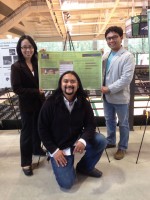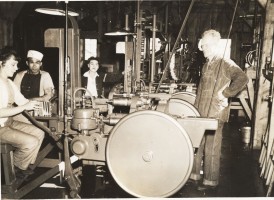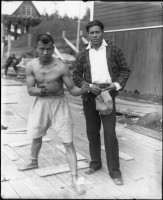Debunking the myth of the 'model minority'
by Kathleen McCoy |

Professors Joy Mapaye, E.J. David and Gabe Garcia standing near their research poster at the Faculty Research and Creative Activity Symposium. (Photo by Dyan Garcia/University of Alaska Anchorage)
You won't get accurate answers if you don't ask the right questions of the right people.
In research, that matters. Gabe Garcia, a public health professor at UAA, wanted to better understand high rates of diabetes, hypertension and cardiovascular disease among Asian and Pacific Islanders-the fastest growing and third largest racial group in Alaska.
That broad label packs within it huge swathes of very different people with very different cultures, habits and experiences. Garcia wanted to drill down and learn much more.
One thing he found is fully half of the APIs in Alaska are Filipino. They've been a part of Alaska's landscape since the mid-1800s, when records in the New Bedford Whaling Museum identified boat crewmembers as "Manilla men."

The photo was taken in a cannery in Kodiak. This area was called the can shop. Basically the reformer is a machine that takes flat cans and makes them round, another machine called a seamer puts on the lid. The job was very boring but we never complained as it was warm in the can shop and dry. (Kodiak Historical Society)
By the early 1900s, Filipino cannery workers, calling themselves "Alaskeros," were living and working in Alaska. About 50 Alaska Filipinos were drafted to serve the U.S. in World War I. Social clubs and community groups began to surface as early as the 1920s in Juneau and later in Ketchikan. The Filipino community in Anchorage organized about 1957. (View a short slideshow of historical images of Filipinos living and working in early Alaska here.)
How this long-standing sub group, as well as more recent arrivals in the umbrella group, were faring health-wise drove Garcia's curiosity. Beginning in 2008, he and several UAA colleagues-Joy Mapaye in journalism and communication and E.J. David in psychology-began interviewing members of the API communities in Barrow, Kodiak and Anchorage. They wanted to assess the mental health of these groups and look for driving social and economic factors.
All three researchers were born in the Philippines (Garcia and David even went to the same elementary school there), but grew up and completed higher education in the United States. As Mapaye pointed out, "There is something to be said for researchers who are actually working within the context of their study, instead of just studying it as outside observers. We are a part of this community and we care about it very much. It's something we want to shed light on."
These same colleagues joined together in 2011 to offer an interdisciplinary class for undergraduates exploring health disparities among Asian Americans and Pacific Islanders. The goal of the class was to engage undergraduates in research and develop a survey tool to gather attitudes and information from this target group.
Each professor had different research questions. Beyond Garcia's public health concerns, Mapaye wanted to know what sources APIs use to obtain health information. David wanted to probe mental health issues, including depression and underlying causes.

Pictured here are two Filipino cannery workers from Yakutat, one of whom boxed in matches that workers could bet on before or after work. This photo was taken sometime between 1912 and 1941. (Fhoki Kayamori, ASL-P55-298, Alaska State Library)
Now, after assembling and analyzing data and interviews from more than 200 participants in Barrow, Kodiak and Anchorage, professors and students have surprising results. Their work debunks the myth of the "model minority," Asian immigrants who have quietly assimilated and succeeded professionally and financially.
Groups that U.S. immigration policy favored-those educated in their home countries who walked into waiting jobs in America-have indeed thrived. But for U.S.-born Filipinos, for example, the story is much different: low high school graduation rates, and equally low college admission rates. They are not thriving.
From the Alaska study, two important findings:
Surprisingly high rates of depression. Sixty percent of those surveyed reported feeling depressed within the last month. Isolating just Filipino Americans from the larger group, the rate drops to 30 percent. That compares to a national norm of roughly 10-15 percent for most Americans.
Discouraged health-care seekers. Many APIs report being frustrated in their attempts to get health questions answered. In interviews, they described providers who don't understand their questions or brush them off. Many feel so misunderstood that they no longer bother asking any questions. Instead, they simply turn to the web in search of health information from sites originating in their home countries.
This study, the first of its kind, is considered exploratory. But as the three researchers see it, high depression rates attached to a group discouraged over its ability to obtain good health-care information is significant. It suggests many APIs simply aren't getting help they need and deserve.
The public health research world is interested. Already the trio has been invited to present before the international World Conference on Epidemiology and the Alaska Public Health Association. Soon they will report to the National Conference for American Public Health. Besides delivering their results in as many venues as they can, they say they will seek more resources for deeper work.
Professor David has been invited to host the first ever national Filipino American Mental Health webinar through the NIH SAMHSA's Office of Behavioral Health Equity (OBHE) and the White House Initiative on Asian American Pacific Islanders (WHIAAPI) on Wednesday, Oct. 29, 2014 from 12-1 p.m. Eastern Time (4-5 p.m. Alaska Time)
A version of this story by Kathleen McCoy appeared in the Alaska Dispatch News on Sunday, Oct. 12, 2104.
https://www.flickr.com/photos/127792578@N02/sets/72157648567456446/show
 "Debunking the myth of the 'model minority'" is licensed under a Creative Commons Attribution-NonCommercial 4.0 International License.
"Debunking the myth of the 'model minority'" is licensed under a Creative Commons Attribution-NonCommercial 4.0 International License.














